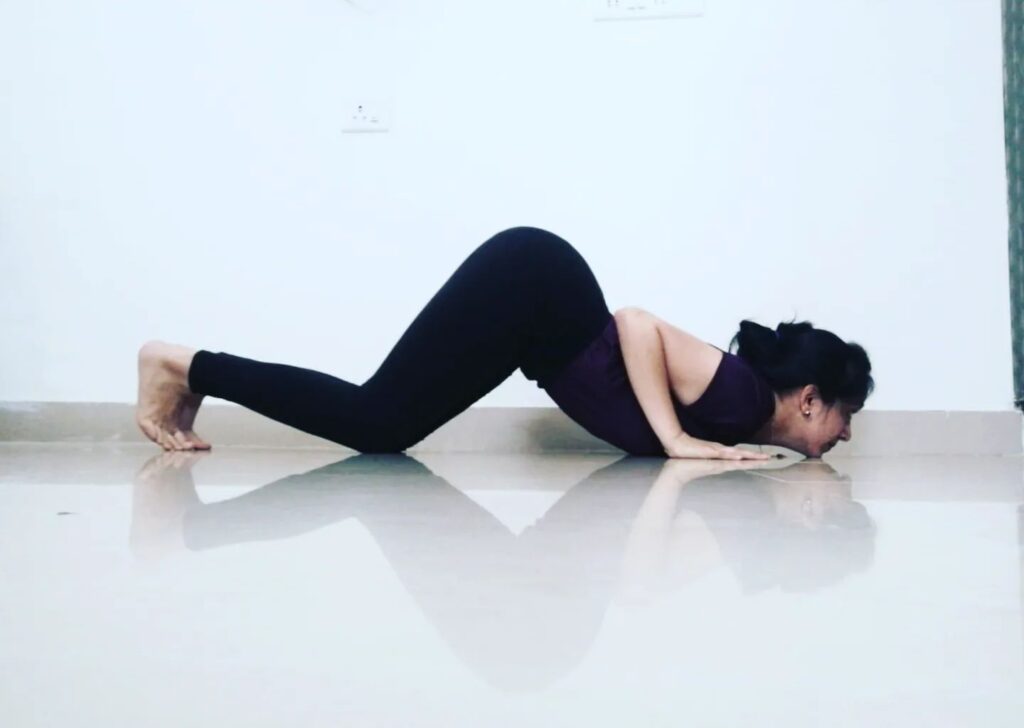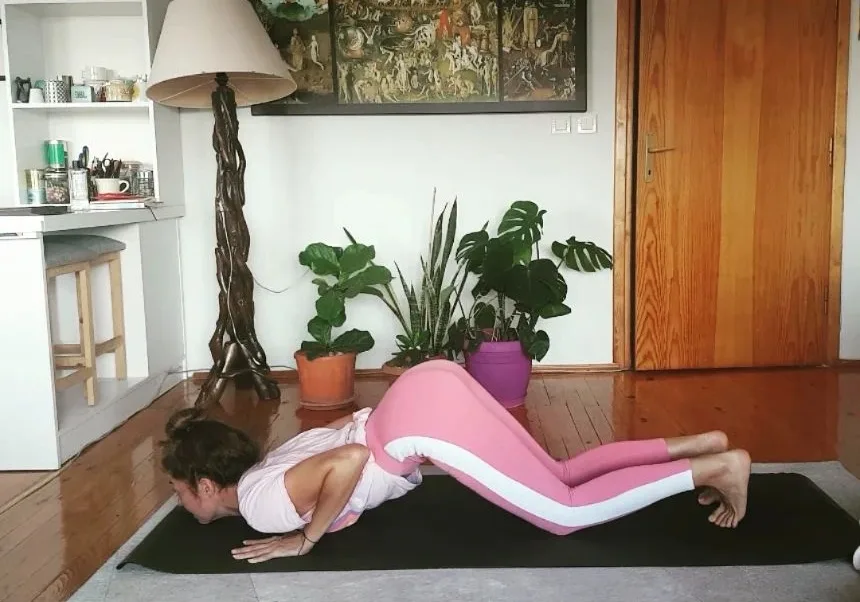Ashtangasana, also known as Ashtanga Namaskara or Eight Limbed Pose, stretches the neck and shoulders, while strengthening the arms and upper body, as well as lengthening and realigning the spine.
Information
| Known as: | Ashtangasana, Ashtanga Namaskara, Ashtanga Dandavat Pranam, Eight Limbed Pose, Caterpillar Pose, Chest Knees and Chin Pose, Eight Limb Prayer Pose, Eight Point Pose, Salutation with Eight Limbs Pose, Salute With Eight Limbs Pose, Four Limbed Staff Pose Knees Chest Chin Floor Pose, Chaturanga Dandasana Knees Chest Chin Floor Pose |
| Sanskrit name: | अष्टाङ्गासन; अष्टाङ्ग नमस्कार |
| IAST: | aṣṭāṅgāsana; aṣṭāṅga namaskāra |
| Pronunciation: | aash-tanh-GAHS-ah-nuh; aash-tanh-GAH namah-SKAR-ah |
| Level: | Beginner |
| Type: | Strength, prone, arms, leg support, balancing |
| Focus: | Entire back, spine, arms, neck, shoulders |
| Total time: | 30 to 60 seconds |
| Drishti: | Forward; Tip of nose (Nasikagra or Agochari) |
| Chakra: | Manipura Chakra, Swadisthana Chakra, Muladhara Chakra |
| Indications: | Internal organs, digestion, abdominal |
| Counterposes: | Child’s pose (Balasana), Downward facing dog (Adho Mukha Svanasana), Cobra pose (Bhujangasana), Cat-cow stretch (Marjaryasana-Bitilasana), Forward fold (Uttanasana) |
| Preparatory poses: | Plank Pose (Phalakasana), Low plank pose (Chaturanga Dandasana), Cobra pose (Bhujangasana), Lotus Pose (Salabhasana), Upward facing dog (Urdhva Mukha Svanasana), Eagle Pose (Garudasana), Sun salutations (Surya Namaskar) |
| Follow-up poses: | Upward Facing Dog Pose (Urdhva Mukha Svanasana), Boat pose (Navasana), Cobra Pose (Bhujangasana), Child’s Pose (Balasana), Downward Facing Dog Pose (Adho Mukha Svanasana), Bridge pose (Setu Bandha Sarvangasana), Tree pose (Vrksasana), Corpse pose (Savasana) |
| Contraindications: | Blood pressure, migraine, neck, shoulder, wrists, neck, hips, knees, ankles, toes, pelvis, or elbow injuries, carpal tunnel syndrome, herniated disc or spondylolisthesis, pregnant women |
Meaning
The Ashtangasana is derived from the Sanskrit name, which is made up of two words — Ashtanga + Asana:
- “Ashtanga” = “eight limbs”
- “Asana” = “posture or pose”
The Ashtanga Namaskara is derived from the Sanskrit name, which is made up of four words — Ashta + Anga + Namaskar + Asana:
- “Ashta” = “eight”
- “Anga” = “limb or part”
- “Namaskar” = “bowing, or a prayer, or a greeting, or salutation”
- “Asana” = “posture or pose”
In Ashtanga Namaskar (Knees Chest Chin Pose is also known by another name) the body touches the ground in eight parts during the practice of the pose. Eight parts of the body, i.e., two feet, two knees, two palms, chest, and chin touch the ground. Salute With Eight Limbs, a literal translation of the Sanskrit name for Asana.
In this practice, the practitioners take the posture of saluting by lying down on the ground by keeping the eight parts or limbs of their body in contact with the ground. This form of Namaskar is practiced in the Indian tradition to seek the blessings of elders or to wish or greet in front of deities or saints and sages.
Acting as a transition pose, the body is balanced and rests on the chest, chin, palms, knees and feet, making it a great pose for strengthening the muscles of the arms, as well as the core.
Knees Chest Chin Pose is part of the classical Hatha Surya Namaskar (Sun Salutation), which consists of a space between the Plank Pose or Downward Facing Dog Pose and Cobra Pose.
This Asana can be a great preparation pose for Four Limbed Staff Pose (Chaturanga Dandasana), or forward arm balancing pose.
Benefits of Ashtangasana (Eight Limbed Pose)
One of the many great benefits of regular practice of this yoga posture is to make the body strong and flexible.
The physical and mental benefits of this yoga pose are listed below:
- Physical Benefits:
- Stretches the toes, soles, hips, lower back, and neck
- Opens the chest
- Strengthens the core, abdomen, chest, biceps, triceps, knees, and entire back
- Tone the limbs (upper limb and lower limb)
- Maintain the natural curvature of the spine
- Improve posture and flexibility
- Stimulate the internal organs
- Helps to boost energy in the body
- Relieves back pain
- Mental Benefits:
Ashtangasana (Eight Limbed Pose) Practice Guide
Knee, chest, and chin alignment is an essential part of Ashtangasana (Chest Knees and Chin Pose), and its alignment is equally important to keep the body comfortable and relaxed. By being aware of these three parts, and connecting to these stretches and pressure, the body communicates when it needs improvement.
Hence, alignment plays an essential role to get the best out of this yoga pose. One of the most essential aspects of this posture is that, it helps in stabilizing the mind, instilling confidence throughout the Asana.
Therefore, learning to go beyond mere physical benefits is the most indispensable aspect of yoga practice, and can be achieved with this yoga posture.
Follow the instructions below to practice these Asanas safely. It will help you in the complete practice of the pose.
Step-by-step instructions

- Begin with Phalakasana (Plank Pose). Make sure the shoulders are directly over the wrists.
- Exhale, and slowly lower your knees to the ground, toes tucked down.
- Bend your elbows and point them back toward the back of the mat. Raise the hips. Engage the bottom of your pelvis (pelvic floor or mula bandha) and pull your abs (transverse abdominis or uddiyana bandha).
- While lowering the chest, spread the chin/forehead forward and bring the chin/forehead down to the ground.
- Lower the chest and pelvis slightly, so that you can also bring the chest down to the ground.
- Keep hugging the sides, butts are raised high, toes stay tucked under.
- Stay in this position for 4-12 breaths.
- To come out of the pose, pull back with the hands and slide the chest forward to come into Cobra Pose or Upward Facing Dog Pose. Then press back into Child’s Pose for a few breaths.
- Repeat this pose 3 more times to get the most out of this pose.
Anatomy engaging tips
Be gentle and practice the pose slowly, do not rush it. When you lower your body into the pose, the back muscles are engaged. That’s why you need to see that your body doesn’t get into a posture that causes pain or discomfort. If you feel pain or discomfort, move the chest as low as you can without pain.
Engaging the right muscles and body alignment is important in any yoga posture, including Eight Limbed Pose (Ashtangasana). Here are some tips on how to engage the anatomy during the pose:
- Core engagement: To engage your core, draw your navel towards your spine and keep your abdominal muscles contracted. This helps to stabilize the torso and protects the lower back.
- Shoulder blade engagement: Draw your shoulder blades down your back and away from your ears. This helps to stabilize the shoulders and prevents them from hunching up towards your neck.
- Arm and wrist engagement: Keep your elbows close to your sides and your arms engaged, with your palms pressing firmly into the ground. This helps to support your body weight and prevents any strain on the wrists.
- Leg engagement: Engage your legs by keeping them straight and strong, with your heels pressing back. This helps to activate the muscles in the legs and prevent them from sinking towards the ground.
- Full body alignment: Make sure that your body is in a straight line from your head to your heels, with no sagging or arching in the lower back. This helps to maintain proper alignment and prevent any strain on the lower back.
By engaging these muscles and maintaining proper alignment, you can help to make the pose more stable, comfortable, and safe. Remember to breathe deeply and focus your attention on your body to stay present and mindful during the pose.
Common mistakes
As with any yoga posture, there are some common mistakes to watch out for in Eight Limbed Pose (Ashtangasana). Here are some of the most common mistakes and how to avoid them:
- Dropping the hips: One of the most common mistakes in Eight Limbed Pose is allowing the hips to drop towards the ground. To avoid this, engage your core and leg muscles to maintain a straight line from your head to your heels.
- Collapsing the shoulders: Another common mistake is collapsing the shoulders and hunching them up towards the neck. To avoid this, draw your shoulder blades down your back and away from your ears, and keep your chest lifted.
- Flaring the elbows: Allowing the elbows to flare out to the sides can put unnecessary strain on the shoulders and wrists. To avoid this, keep your elbows close to your sides and your forearms parallel to each other.
- Arching the lower back: Arching the lower back can put strain on the lumbar spine. To avoid this, engage your core and pelvic floor muscles to maintain a neutral spine.
- Sinking into the arms: Allowing the weight to sink into the arms can put strain on the wrists and forearms. To avoid this, engage your arm muscles and press firmly into the ground through your palms and fingertips.
Modifications
If you’re new to yoga or have any injuries or limitations, there are modifications you can make to Eight Limbed Pose (Ashtangasana) to make it more accessible. With practice, you may find that you’re able to move deeper into the pose over time.
Here are some modifications you can try:
- Modified low plank: Instead of lowering your body all the way to the ground, you can modify the pose by lowering your knees to the ground first, and then lowering your body down to create a straight line from your head to your knees.
- High plank: If you find the low plank position too challenging, you can practice the high plank pose instead. In high plank, you keep your arms straight and your body in a straight line, with your shoulders over your wrists.
- Forearm plank: Another modification is to practice the pose on your forearms instead of your hands. In forearm plank, you lower your forearms to the ground and lift your body up into a straight line from your head to your heels.
- Using props: You can also use props such as blocks or blankets to make the pose more accessible. Place a block or blanket under your chest to support your upper body, or under your knees to reduce the strain on your wrists.
Precautions and contraindications
There are precautions and contraindications you should keep in mind to avoid injury while practicing Ashtanga Namaskara (Eight Limbed Pose).
Precautions and contraindications for the same are explained below:
Injury and surgery
Practicing Caterpillar Pose (Chest Knees and Chin Pose) puts a lot of strain on the joints and muscles throughout your body. Therefore, if any part of the body is injured, or is recovering from surgery, then the practice of this yoga posture should be avoided.
Injury to your shoulders, elbows, wrists, neck, hips, knees, lower back, ankles, toes, pelvis, etc. should be reported to your yoga teacher/instructor to avoid injury.
Slip disc and spondylolisthesis
Individuals, regardless of age, recovering from a herniated disc or spondylolisthesis should avoid the practice of Ashtanga Namaskara.
Arthritis and lower back pain
People who are battling with their back pain issues, or suffering from arthritis, should completely avoid the practice of Ashtangasana.
Migraine and blood pressure
If individuals are not yet comfortable with your breathing and body awareness, that is, if you suffer from blood pressure or have a migraine, as breathing can be restricted while trying to keep the body in balance, and this is not safe for in such individuals.
Pregnant women
In general, pregnant women should avoid the practice of Ashtangasana because there is a lot of pressure in the abdominal region with active use of the pelvic floor muscles.















